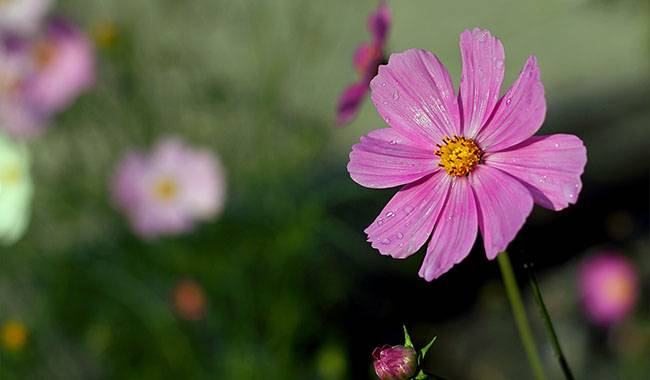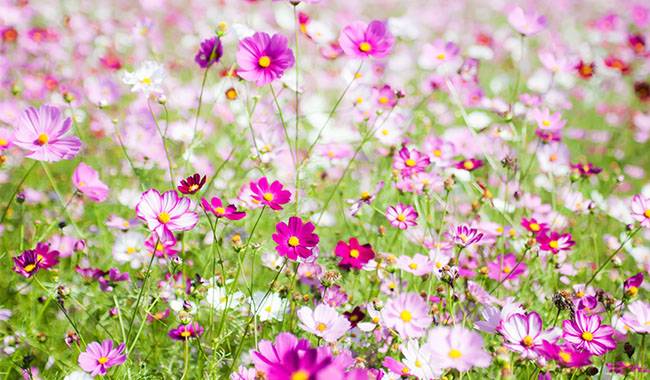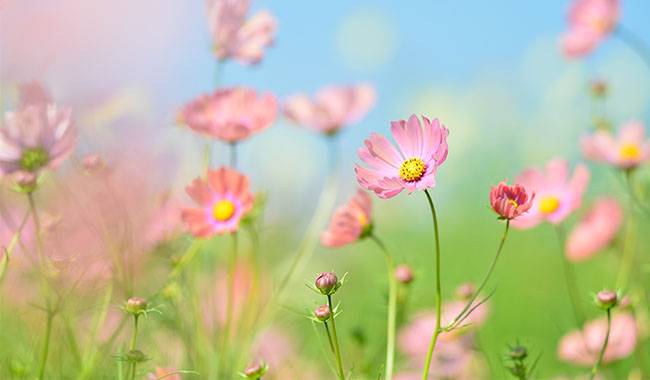
What is cosmos?
cosmos is the name of a widely spread annual garden plant in the Asteraceae family, very often referred to as cosmos, beautiful. It is native to Mexico, Brazil, and all parts of Central America.
If you plant this sunny and showy cosmos, your garden will be transformed and become colorful. With proper care, the cosmos will thank you with beautiful flowers.
Previously this plant and flowers were not taken, but thanks to the work of breeders were bred new varieties of cosmea that now decorate our gardens and please with their bright and delicate colors almost all summer. The fruit is a slender seed pod with no crest.
The most popular is Cosmos bipinnatus (C. bipinnatus), a native of the Mexican highlands. It soon spread to Europe because of its unpretentiousness and ability to reproduce by self-seeding.
Another species of this genus, C. sulphureus cosmos (C. sulphureus), also came to Europe long ago, but for some reason did not receive such popularity.
Although it seems, its appearance should be closer to that of the inhabitants of the central United States: its yellow inflorescences are very similar to the flowers of the couch.
Both cosmos are herbaceous annuals with straight and strong branches and strong branching. The inflorescences have non-punchy, semi-punchy, and punchy baskets.
The inflorescence of cosmos bipinnate is up to 5inch (12cm) in diameter, white and pink or purple, sometimes with a ring around the center. The height is 12-47inch (30-120 cm).
There are some forms of inflorescences that resemble sunflowers with ligulate flowers folded into large tubes. cosmos sulfur, 12-40inch (30-100 cm) tall, inflorescences 2-3inch (5-8 cm) in diameter, in yellow, orange, and red.

The cosmos flower is hardy, light-loving, and relatively drought-tolerant. It grows in any kind of soil but blooms more in loose, nutrient-rich soil. The flowering period is from June until severe frosts.
Propagated by seeds (1 gram contains 140-200 seeds). Seeds remain germinating for 5 years. As soon as the soil warms up in spring, seeds can be sown under winter.
Seeds are best sown in clumps, 2-3 pieces, 8-16inch (20-40 cm) apart, depending on the height of the variety. When the first and second true leaves appear, thin the seedlings, leaving one seedling in the nest.
Low-growing varieties and heterohybrids, as well as varieties with very large inflorescences (polyploids), are better planted by seedlings.
In this case, seeds are sown in pots of 2-3 blocks at the beginning of April in a very light and cool place at 59-62°F (15-17°C). Sprouting appears after 8-12 days.
Seedlings of high-growing varieties can be pruned at the 5-7 leaf stage to enhance branching, although this will delay flowering slightly. seedlings are sown in May.
Cosmea care is not complicated. Too much organic fertilizer in the soil can harm them because in this case, they form strong bushes and flowers late and weakly.
Feeding the plants with a complete compound fertilizer will ensure that they grow well and flower abundantly. Start fertilizing a week after planting or after setting seedlings, at intervals of 10-14 days, until flowering.
Watering is done only in the early stages of cosmos plant growth and when the soil is too dry.
At the end of summer, it is time to let the flowers rejoice and then collect the seeds for planting next season. Translated from Latin, the name cosmos sounds very romantic “cosmos”. His plants are given a plethora of colorful flowers and feathery foliage that resemble constellations in the night sky.
According to American garden experts, the cosmos blooms until autumn frost. From mid-September they gradually bear fruit, and in the last week of that month, it is already possible to collect seeds and sow them next year.
In usual climatic conditions, they have time to mature. If this is not done, the plant will self-sow and the decorative quality of the flowers will not be reduced as a result.
cosmos is an annual plant and therefore easy to grow. The seeds are sown in a non-sowing manner into the open ground at a distance of 14-16inch (35-40cm) from each other. They germinate within 7-10 days.
In order for the plant to flower in August, the cosmos must be planted in May. it is frost resistant and, like many Asteraceae, can withstand cold of minus 3 degrees.
cosmos does not require careful care but does require standard practice – watering and weeding. Then again, this plant will make the gardener very happy.
It is important to remember that the cosmos can grow on any soil, says the professional gardener. The supply of water is not important for it either. An only condition is a sunny place; it will not develop in the shade.
The unpretentiousness of the cosmos has become a major factor in the popularity of this ornamental plant among gardeners. It can be used not only for country gardening but also for urban environments.
Its flowers look great in individual plantings and in container gardening: it is a very successful addition to any composition and border. In addition, the whole plant is perfect for bouquets and dried flower creations.
Today, there are many different types and varieties of cosmos on sale, but most often it is sold with various mixtures. The most demanded varieties are cosmos, double plumage, gray-yellow and blood-red.
They grow up to one and a half meters tall, flowers reach 9 cm in diameter, and can grow up to 30-40 pieces on the bush. the cosmea color range includes almost all shades but usually can be found in white, pink, and red flowers. Foreign selections of exotic varieties – dwarf, double and rapid flowering – also appear on the market.
Tip
The home of the cosmos is the tropical region of the United States. There it is called “Mexican aster”. There are more than 40 known species of this plant, mainly annuals. cosmos came to Europe at the end of the 18th century and began to be planted all over the world only about a century later. In the south, it is often found as a weed along roadsides.





